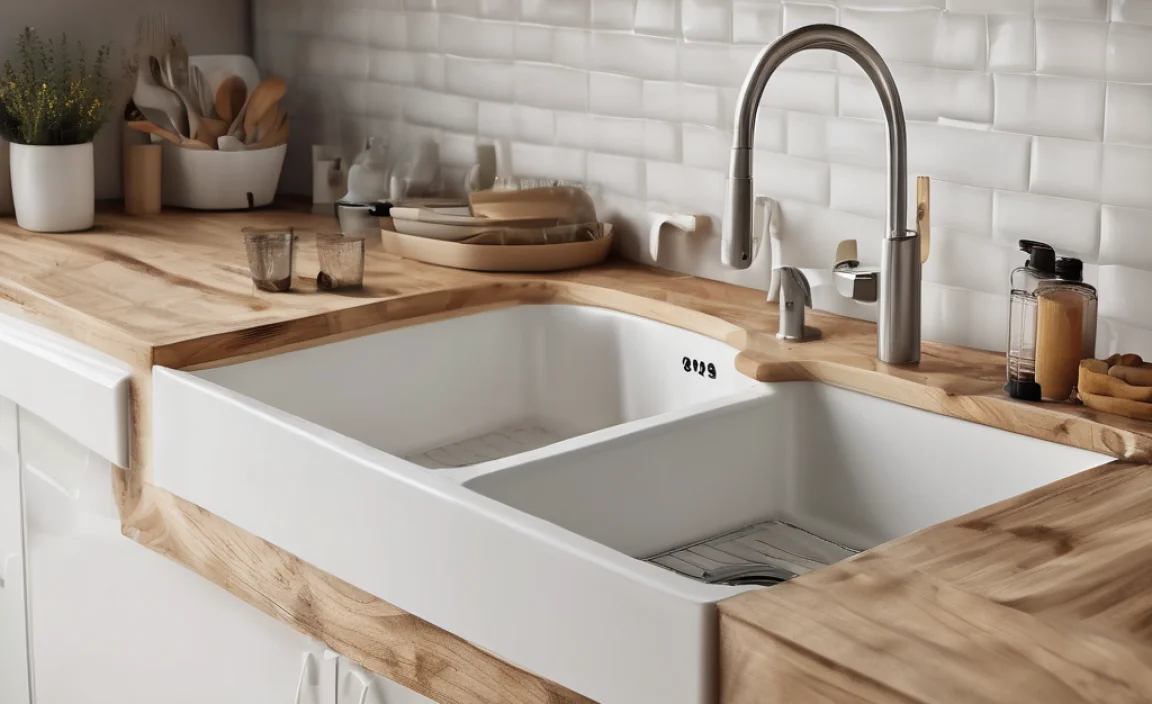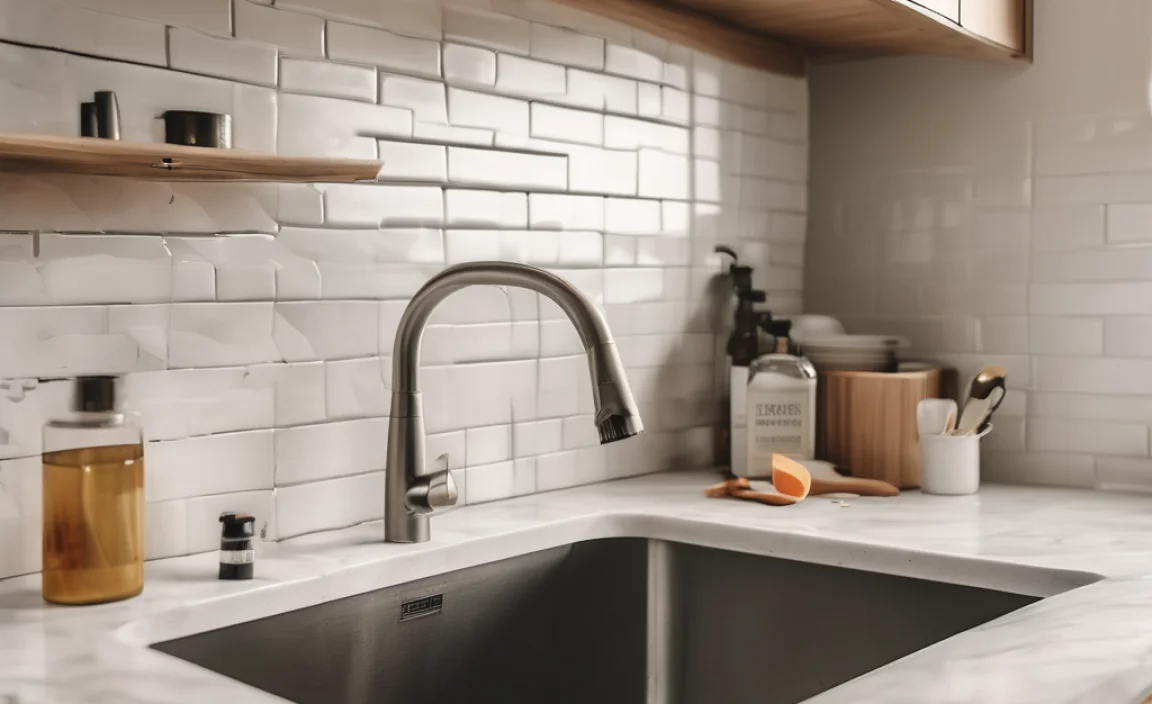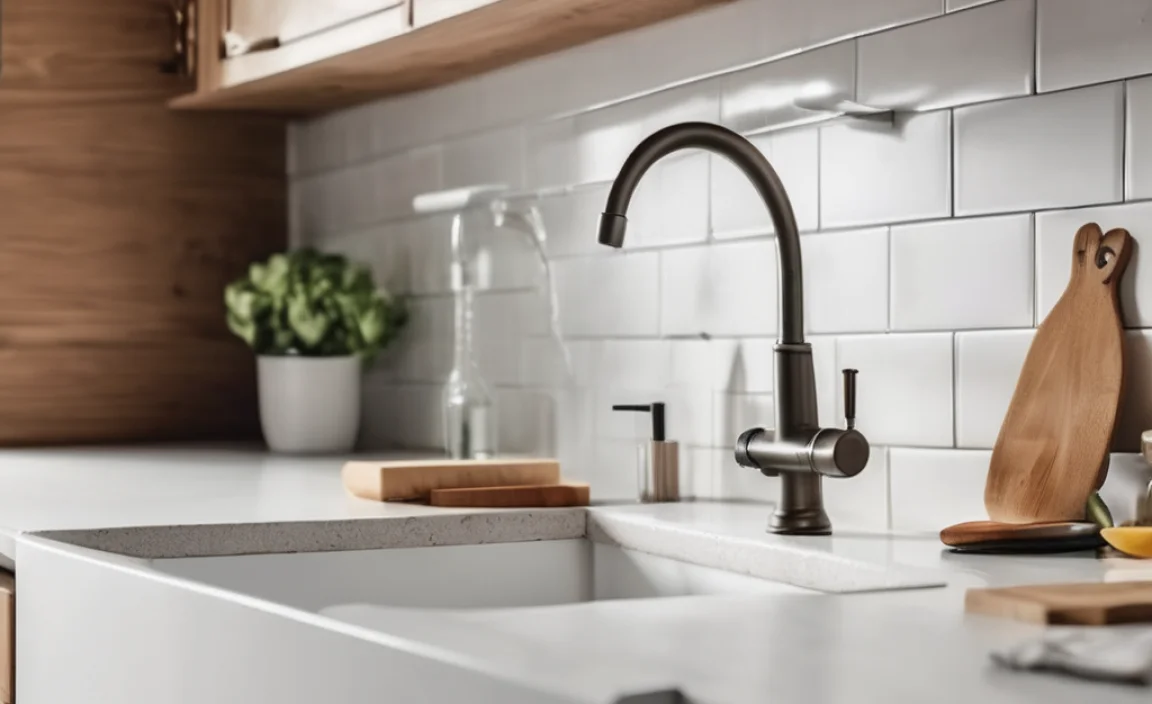Replacing the wood under your kitchen sink might sound daunting, but it’s totally doable! First, turn off the water and clear everything out. Then, cut away the damaged wood, measure and cut a new piece, and secure it in place. Seal it up to prevent future water damage, and you’re all set. Follow these steps for a dry, sturdy sink base!
Is the wood under your kitchen sink soft, stained, or even crumbling? Don’t worry, you’re not alone! Leaks and spills happen, and they can wreak havoc on that cabinet base. It might seem like a big deal, but replacing that damaged wood is a straightforward DIY project.
In this guide, we’ll walk you through each step, from prepping the area to sealing the new wood. By the end, you’ll have a solid, water-resistant base under your sink. Let’s get started!
Tools & Materials You’ll Need

Before you start, gather these tools and materials to make the job smooth and efficient:
- Safety Glasses: Protect your eyes from debris.
- Gloves: Keep your hands clean and safe.
- Utility Knife: For scoring and cutting caulk.
- Pry Bar or Putty Knife: To remove old wood carefully.
- Measuring Tape: Essential for accurate cuts.
- Pencil: For marking measurements.
- Circular Saw or Hand Saw: To cut the new wood.
- Sandpaper: To smooth rough edges.
- Drill/Driver: To secure the new wood.
- Screws: For attaching the new wood.
- Exterior-Grade Plywood or Wood: Choose a rot-resistant material.
- Construction Adhesive: For a strong bond.
- Caulk: To seal gaps and prevent water damage.
- Shop Vacuum or Broom: To clean up debris.
- Old Towels or Sponges: To soak up any water.
Step-by-Step Guide to Replacing Wood Under the Kitchen Sink

Follow these steps carefully to replace the damaged wood under your kitchen sink and restore your cabinet’s integrity.
Step 1: Prep the Area
Start by creating a clean and safe workspace.
- Turn Off the Water: Locate the shut-off valves under the sink and turn them off. If you don’t have individual valves, turn off the main water supply to your house.
- Clear Out the Cabinet: Remove everything from under the sink – cleaning supplies, trash cans, etc. This gives you clear access to the damaged area.
- Protect the Area: Lay down old towels or a drop cloth to protect the surrounding floor from debris and water.
Step 2: Assess the Damage
Take a good look at the damage to understand the scope of the repair.
- Identify the Affected Area: Determine how much of the wood needs to be replaced. Check for soft spots, stains, or crumbling areas.
- Check for Leaks: Look for any active leaks or signs of past leaks. Repair any leaks before replacing the wood to prevent future damage.
- Take Pictures: Document the damage before you start. This can be helpful for reference later.
Step 3: Remove the Old Wood
Carefully remove the damaged wood. This step requires patience to avoid damaging the surrounding cabinet structure.
- Score the Edges: Use a utility knife to score along the edges of the damaged wood where it meets the cabinet walls. This helps to prevent chipping or splintering.
- Pry Off the Wood: Use a pry bar or putty knife to gently pry the damaged wood away from the cabinet. Work slowly and carefully to avoid damaging the surrounding structure.
- Remove Fasteners: If the wood is attached with nails or screws, remove them with a screwdriver or drill.
- Clean the Area: Once the old wood is removed, clean the area thoroughly with a shop vacuum or broom. Remove any debris, dirt, or old adhesive.
Step 4: Measure and Cut the New Wood
Accurate measurements are crucial for a proper fit.
- Measure the Opening: Use a measuring tape to measure the exact dimensions of the area where the old wood was removed. Measure the width, depth, and thickness.
- Cut the New Wood: Transfer the measurements to a new piece of exterior-grade plywood or wood. Use a circular saw or hand saw to cut the wood to the correct size.
- Test the Fit: Place the new piece of wood into the opening to test the fit. It should fit snugly but not too tightly. If necessary, trim the edges with a saw or sandpaper for a perfect fit.
Step 5: Prepare the New Wood
Prepping the new wood ensures a strong and durable repair.
- Sand the Edges: Use sandpaper to smooth any rough edges or splinters on the new wood. This will help it fit better and prevent injuries.
- Apply a Sealant (Optional): For added protection, you can apply a sealant or primer to the new wood before installation. This will help to prevent moisture damage and prolong its life.
Step 6: Install the New Wood
Secure the new wood in place using construction adhesive and screws.
- Apply Adhesive: Apply a generous amount of construction adhesive to the back of the new wood and to the surrounding cabinet frame.
- Position the Wood: Carefully position the new wood into the opening, pressing it firmly against the cabinet frame.
- Secure with Screws: Use a drill/driver to secure the new wood to the cabinet frame with screws. Use screws that are long enough to penetrate the frame but not so long that they poke through the other side. Space the screws evenly around the perimeter of the wood.
- Allow to Dry: Allow the construction adhesive to dry completely according to the manufacturer’s instructions. This may take several hours.
Step 7: Seal the Edges
Sealing the edges prevents water from seeping in and causing future damage.
- Apply Caulk: Apply a bead of caulk along all the edges where the new wood meets the cabinet frame.
- Smooth the Caulk: Use your finger or a caulk smoothing tool to smooth the caulk and create a watertight seal.
- Allow to Dry: Allow the caulk to dry completely according to the manufacturer’s instructions.
Step 8: Final Touches
Complete the project with these final steps.
- Clean Up: Clean up any debris or mess created during the project.
- Replace Items: Put back all the items you removed from under the sink.
- Check for Leaks: Turn the water back on and check for any leaks around the sink and faucet. If you find any leaks, tighten the connections or call a plumber.
Choosing the Right Wood

Selecting the right type of wood is crucial for a long-lasting repair. Here’s a comparison of common options:
| Wood Type | Pros | Cons | Best Use |
|---|---|---|---|
| Exterior-Grade Plywood | Water-resistant, durable, affordable | Can be prone to warping if not sealed properly | Best overall choice for most kitchen sinks |
| Marine-Grade Plywood | Highly water-resistant, resists rot and decay | More expensive than exterior-grade plywood | Ideal for high-moisture environments |
| Cedar | Naturally water-resistant, attractive appearance | Softer than plywood, can be easily damaged | Good for aesthetic appeal, but less durable |
| Treated Lumber | Resistant to rot, insects, and decay | May contain chemicals, not ideal for enclosed spaces | Suitable for areas with extreme moisture |
Tips for Preventing Future Damage

Once you’ve replaced the wood, take steps to prevent future water damage.
- Regularly Check for Leaks: Inspect the plumbing under your sink regularly for any signs of leaks. Address any leaks promptly to prevent water damage.
- Use a Sink Mat: Place a waterproof mat under the sink to catch any spills or drips.
- Wipe Up Spills Immediately: Clean up any spills or drips as soon as they happen to prevent water from seeping into the wood.
- Improve Ventilation: Ensure proper ventilation under the sink to help moisture evaporate. You can install a small fan or leave the cabinet door slightly ajar.
- Apply a Waterproof Coating: Consider applying a waterproof coating to the inside of the cabinet to protect the wood from moisture.
Cost Considerations

Here’s a breakdown of the costs involved in replacing the wood under your kitchen sink:
| Item | Estimated Cost |
|---|---|
| Exterior-Grade Plywood | $20 – $50 |
| Construction Adhesive | $5 – $10 |
| Caulk | $5 – $10 |
| Screws | $5 – $10 |
| Total | $35 – $80 |
These are just estimates, and the actual cost may vary depending on the materials you choose and where you purchase them. If you need to hire a professional plumber or handyman to do the job, labor costs can add an additional $100 – $300 or more.
Safety First
Safety is paramount when undertaking any DIY project. Keep these tips in mind:
- Wear Safety Glasses: Protect your eyes from flying debris.
- Wear Gloves: Protect your hands from splinters and chemicals.
- Work in a Well-Ventilated Area: If using adhesives or sealants, ensure adequate ventilation to avoid inhaling harmful fumes.
- Use Caution with Power Tools: Follow the manufacturer’s instructions and use appropriate safety precautions when using power tools.
- Turn Off the Power: If you’re working near any electrical wiring, turn off the power at the circuit breaker.
FAQ: Replacing Wood Under the Kitchen Sink
1. How do I know if the wood under my sink needs replacing?
Look for signs like soft spots, discoloration, mold, or a musty smell. If the wood feels weak or crumbles easily, it’s time to replace it.
2. What kind of wood should I use?
Exterior-grade plywood is a great option because it’s water-resistant and durable. Marine-grade plywood is even better for high-moisture areas, but it’s more expensive.
3. Can I just cover up the damaged wood?
Covering it up is a temporary fix. The underlying rot and moisture will continue to cause problems. It’s best to replace the damaged wood for a long-term solution.
4. Do I need to hire a professional?
If you’re comfortable with basic DIY tasks, you can likely handle this project yourself. But if you’re unsure or encounter plumbing issues, it’s best to call a plumber or handyman.
5. How can I prevent future water damage?
Regularly check for leaks, use a sink mat, wipe up spills quickly, and ensure good ventilation under the sink. Applying a waterproof coating can also help.
6. What if the leak is coming from the pipes?
Address the leak before replacing the wood. Tighten any loose connections or replace worn-out pipes. If you’re not comfortable with plumbing repairs, call a plumber.
7. How long does it take to replace the wood?
Plan for about 2-4 hours, depending on your skill level and the extent of the damage. Make sure to factor in drying time for adhesives and sealants.
Conclusion
Replacing the wood under your kitchen sink is a manageable DIY project that can save you money and prevent further damage. By following these step-by-step instructions, you can restore the integrity of your cabinet and create a dry, sturdy space under your sink. Remember to prioritize safety, take your time, and don’t hesitate to seek professional help if needed. With a little effort, you’ll have a kitchen sink base that’s built to last!
